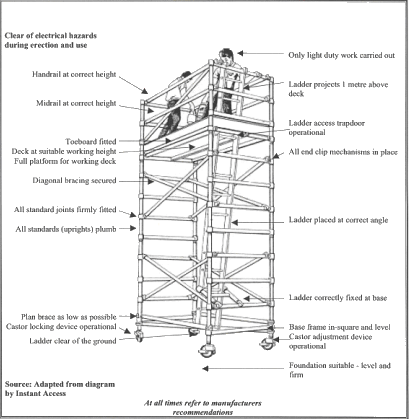Scaffolding Do’s & Dont’s
SCAFFOLDING
Under the Occupational Health and Safety Act 1989 (the Act), employers, persons in control of a workplace and self-employed persons must take all reasonably practicable steps to ensure that persons at or near the workplace are not exposed to health and safety risks.
Falls from height are the most common cause of death on building and construction sites, killing 16 construction workers nationally in 2003. Scaffolds are commonly used to provide temporary platforms for working at height and require detailed attention to safety matters.
SCAFFOLD SYSTEMS
Scaffold working platforms are generally rated as light, medium or heavy duty:
- Light duty – up to 225kg per bay, suitable for work undertaken by a maximum of two people with a maximum of 65kg of tools and materials (eg. painting, electrical work and carpentry tasks). Platforms should be at least 2 planks wide.
- Medium duty – up to 450 kg per bay, suitable for general trades work. Platforms should be at least 4 planks wide.
- Heavy duty – up to 675 kg per bay, required for bricklaying, concreting, demolition work and other tasks involving heavy loads or impact forces. Platforms should be at least 5 planks wide.
Scaffolding of more than 4 metres in height must be erected, altered and dismantled by a
person with a certificate of competency of the appropriate class, or by a trainee under the direct supervision of a person with a relevant certificate of competency. Information Bulletin 05.01 New Certification Processes for Plant Users and Operators provides further detail.
SCAFFOLDING MAY ONLY BE ACCESSED IF IT IS...
- On a stable, level foundation with proper soleplates and baseplates;
- Properly braced and fully planked;
- Fitted with guardrails, mid-rails and toe boards on the working deck wherever a person or material could fall more than 1.8 metres (mesh screens may also be used to provide additional protection from falling materials);
- Fitted with secure stairs or ladders to access the working deck.
Defective or incomplete scaffolding must not be accessed and should be sign posted “Scaffold Incomplete – Do Not Use”
Scaffolding components must be kept clear of overhead power lines (minimum clearance of 4 metres for metal and 1.5 metres for timber). Advice should be sought from the local electricity supply authority for any reduction to these clearances.
Scaffolds should be protected from impact where there is a likelihood of mobile plant operating near scaffolding, eg. using barricades, buffer rails, concrete or timber kerbs.
MOBILE SCAFFOLDS - ADDITIONAL REQUIREMENTS:

- Follow the manufacturers/ suppliers written instructions
for correct erection, use and dismantling; - Only use mobile scaffolds should on hard level surfaces;
- The wheels of a mobile scaffold should be locked
whenever the scaffold is not being moved; - Do not relocate a mobile scaffold unless all items have been secured against falling;
- No person should be on a mobile scaffold when it is being moved;
- All mobile scaffolds should have a safe, secure means of
access to the working platform; - When moving a mobile scaffold, stay clear of powerlines (the scaffold
should come no closer than 4m). - Do not locate a mobile scaffold closer than 1 metre to any unprotected edge or penetration, unless measures are used to prevent it crossing that point, such as a fixed fence, rail or suitably high ridge.
- Never use scaffold guardrails to gain extra height or to support equipment or loads..
Ladders for scaffolding:
- All ladders must be positioned internally with a slope of 1 in 4;
- Ladders must be securely fastened near the top and bottom to prevent movement;
- Ladders must not touch the ground and must extend 1 metre above the landing served by the ladder
Further information:
Not all hazards and safeguards involved with the use of scaffolding are given here.
Detailed guidance about the selection, installation, use and maintenance of scaffolds is provided in AS/NZS 4576 – Guidelines for Scaffolding, available from Standards Australia at www.standards.com.au or telephone on 1300 654 646





